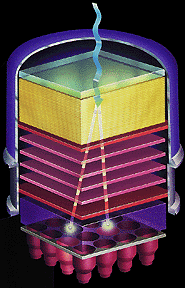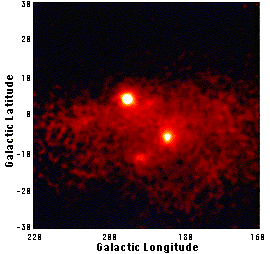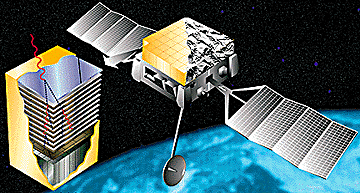The Pair Telescope
The pair telescope is a technology which in its original form as a
spark chamber was borrowed directly from the world of high-energy
physics. At energies above about 30 MeV,
pair
production is the dominant photon interaction in most materials.
A Pair Telescope takes advantage of this process to detect the
arrival of the cosmic photon through the
electron/positron
pair created in the detector. Such telescopes have a long history of use in
high-energy
astrophysics
with experimental spark chamber detectors having been flown on balloons in the late
1960s.
With the advent of the large, sophisticated spark chambers such as COS-B
and EGRET, high-energy
gamma-ray
astronomy has gone from being a discipline for instrumental specialists to
being an integrated part of multiwavelength astronomy. At energies above
30 MeV, celestial objects such as
pulsars,
active galaxies, and
diffuse emission are profitably studied with pair telescopes.
With the use of silicon strip detectors, such as those to be used on
GLAST, we expect a further advance in energy and spatial resolution.
Basic operating principles
The standard instrument design is to have a layered telescope, with
converter layers interleaved with tracking material. The converter is
typically a high Z material (ex. heavy metal such as lead) which provides
the target for creating the initial pair while the tracking material
detects the pair. One type of tracking material is a spark chamber,
which is a gas filled region criss-crossed with wires. Once the
electron/positron pair has been created in one of the converter
layers, they traverse the chamber,
ionizing the
gas. Triggering the detector causes the wires to be electrified,
attracting the free electrons which provides the detected signal. The trail
of sparks essentially provides a three dimensional picture of the the e+/e-
paths. Another type of tracking material is silicon strip detectors,
which consists of two planes of silicon. In one plane the strips are
oriented in the "x"-direction, while the other plane has strips in the
"y"-direction. The position of a particle passing through these two silicon
planes can be determined more precisely than in a spark chamber.
By reconstructing the tracks of the charged pair as it passes
through the vertical series of trackers, the gamma-ray direction
and therefore its origin on the sky are calculated. In addition, through the
analysis of the scattering of the pair (which is an energy dependent
phenomenon) or through the absorption of the pair by a scintillator detector
or a calorimeter after they exit the spark chamber, the total energy
of the initial gamma-ray is determined.

It is very important to keep the chamber from triggering on the
overwhelming flux of cosmic rays. To this end, anti-coincidence shields are
used which cover the entire telescope with a charged particle detector. If
the anti-coincidence shield has detected a charged particle, it won't allow
the chamber to trigger to prevent detecting cosmic rays. In addition, it is
common to have a so-called time-of-flight system, which are detectors which
determine the relative times at which the pair travel through the chamber. In
this way, it can be determined whether the pair came from the correct
direction. The EGRET instrument, shown above, was a successful pair
telescope on the Compton Gamma Ray
Observatory, utilizing the technology of a spark chamber.
Detector characteristics
Given the paucity of photons at higher gamma-ray energies, it is very
important to make these detectors as large as possible. Like an
optical telescope's mirror, the horizontal cross section of the telescope is a
measure of its ability to collect photons. For EGRET, the peak
collection
area was about 1600 cm2, much smaller than air Cerenkov
detectors of course, but as large as many low-energy scintillator experiments.
Pair telescopes operate much like optical telescopes, in that they can take a
"picture" of the region being viewed. The direction of each photon
is measured which allows scientists to image the sky.

The
energy resolution of spark chamber experiments is only about 20%. Losses
in the chamber and the intrinsic resolution of the scintillator are relevant
factors here. At the lowest energies, the resolution worsens since the pair
particles lose energy through multiple scattering as they traverse the
detector. These losses are difficult to account for. At high energies, the
pair energy may be incompletely absorbed in the calorimeter, which can also
limit energy resolution.
The use of silicon strip detectors improves the energy resolution to
about 10%.
Recent developments
Larger is better! Especially for gamma-ray sources above 30 MeV. All
sources of gamma-rays emit fewer photons at higher energies. Therefore at the
highest energies, photons are the most scarce and the need for larger
telescopes is ubiquitous. Spark chamber instruments are wide field-of-view
instruments with collecting area out to 30 or 40 degrees from the center of
the field-of-view. Instruments such as the Fermi Gamma-ray Space Telescope will try to make this even larger.
Related to larger collecting areas is the task of trying to expand the
energy range over which the telescope is sensitive. At lower energies,
one is limited to going down to about 20 MeV, which is the pair
production threshold for most converter materials. Techniques which
improve the
sensitivity of telescopes from about 20 to 100 MeV, in order
to merge with Compton Telescopes, are being researched. At the highest
energies, larger collection areas will possibly allow space-based
gamma-ray detectors to detect sources up to around 100 GeV, which will
merge nicely with ground-based air Cerenkov detectors.

|
The Fermi Gamma-ray Space Telescope
|
The Fermi Gamma-ray Space Telescope, launched in June 2008, is using new
technologies.
Chief among them is the use of solid-state detectors as the tracking material
instead of the gas filled chamber. This will allow for improved energy and
spatial
resolution. Improvements in energy resolution (10% resolution)
and spatial location (0.5-5.0 arcminutes) by Fermi will make great contributions in understanding source
behavior. In addition, a replenishable supply of chamber gas is no longer
needed which will make longer mission lifetimes possible. The potential for
Fermi is great since nearly 200 individual sources of high-energy
gamma-rays have been detected with EGRET, and the possibility of thousands of
sources is the goal of instrument designers.
Updated: September 2008
|
